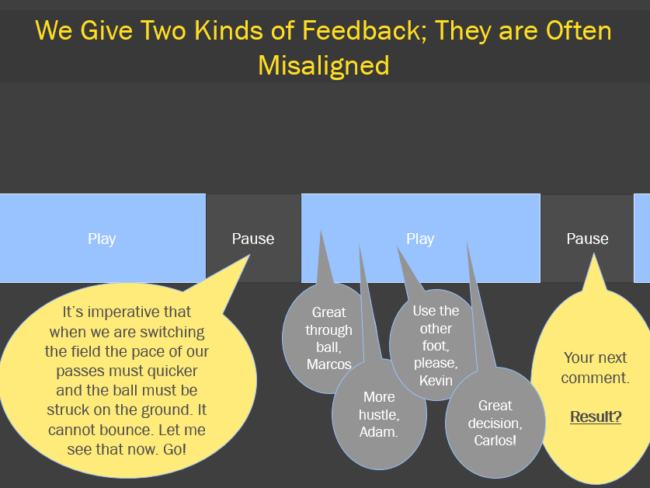01.11.19On Coaching: You Give Two Kinds of Feedback. Are They Aligned??
Here’s a slide I showed recently to coaches at a workshop:

The slide is an attempt to describe a common challenge I see in the teaching/coaching of athletes.
Here’s the scene. Athletes are playing. We are observing them as coaches. We notice something that needs to be improved. So we stop and make a teaching point. All of this is to the good-especially if we can discipline ourselves to talk about just one thing during the stoppage, to say it quickly, and then let players use the guidance right away.
If we can do those things we’re in pretty good shape.
But it’s important to recognize that these “situational stoppages”–brief breaks in an activity when feedback is given–are just one of the ways players get feedback. We also tend to give them “live feedback”: We say things to them while they’re playing. “Yes, good ball, Sarah!” “Play wide, there, Eric!”
In an ideal world these two forms of feedback would work in synergy. We would stop and make our teaching point: “The pace of our passes must be quicker and the ball must be on the ground.” And then as players tried to implement this guidance our live feedback would focus on exactly the same topic: “Strike it even harder, David!” “Yes, that’s what we want, Luis!” “Getting better, Danilo.”
This would accomplish two things. First it would help players to understand and assess how they were doing at accomplishing the task we gave them. They’d learn faster and be more attentive. But second it would reinforce the importance of our teaching points. That we cared and noticed whether players tried to use the feedback they got.
Ironically this doesn’t always happen. Sometimes we make a teaching point during a stoppage–“The pace of our passes must be quicker and the ball must be on the ground”–but then as soon as players start playing again we are distracted by ten thousand things and our live feedback is all over the place: “That ball has to go to Danilo, Carson!” “Better first touch, Kevin” “Yes, Matteo, your eyes are up and scanning.” These other things are important. Maybe one or two are worth saying now. But there’s also an opportunity cost. We’re missing the opportunity to help players focus on the thing we told them to focus on. We’re distracting them from thing #1. And we are communicating, unintentionally, that as soon as we make a teaching point we’re just as likely to have forgotten it ourselves a minute later. If it’s not that important to us, why should it be important to them?
This is what I’d describe as an alignment problem. In an ideal world you’d see alignment. Maybe not every live comment would be about the recent teaching point but many would be.
Happily I’ve just cut a clip of coach James Beeston working with boys at Black Watch Premier–a club I work (and where my kids play… yes, that’s an endorsement).
James stops his boys to discuss the angle of the back pass in an up-back-through combination. He makes one point- the pass should be at an angle, not straight back. He makes it fast. He lets the boys try it right away. But notice, crucially, his self-discipline. Almost everything he says for the next few minutes is about the angle of their passes. Are they getting it right? How can they do it better? and just as importantly, does this coach mean what he says and expect me to try to use what he’s told me?
Here’s the video. I hope it’s helpful!
Beeston.Aligned Feedback.FastandFocused.UpBackThrough.Captions from TLAC Blog on Vimeo.
